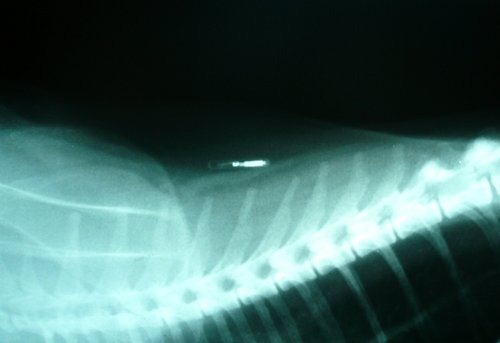 Journalists continue to be snookered by already debunked hoaxes, and perhaps a few too many nights watching Dollhouse. The latest one proclaims that:
Journalists continue to be snookered by already debunked hoaxes, and perhaps a few too many nights watching Dollhouse. The latest one proclaims that:
Tiny GPS microchips with your personal info can be slipped under your skin, leaving you lighter, ID tossed in the shredder.
It sounds like the author was thinking about RFID microchips, such as the feline tracker shown above, which do work, though they have a limited range generally measured in feet.
Alas, there’s no such thing as a GPS implant, at least for the time being. Here are the main technological obstacles to such a device:
Water – The human body is composed mostly of water, which is one of the most effective blocks of a GPS signal. Even a deposit of ice or snow on your windshield or on a handheld GPS antenna is enough to block reception. Unless the chip is implanted immediately beneath the skin, effective reception will likely be blocked.
Transmitter – Not only is a GPS receiver required, but if you’re going to track location, you need a transmitter and antenna too. Hmm, the size of our implant seems to be growing.
Power – We can’t get a handheld GPS to go 24 hours without a battery change, and I’ve yet to see a cellphone go a week without needing to be charged, so what are we going to do? Plugin? Sleep on a Powermat?
Sorry folks. Even though some of you might want to chip your wandering kids and memory-impaired parents, the technology just isn’t there yet.
Image courtesy Joelmills

0024]To reduce the size of the GPS implant, recent transcutaneous recharging systems such as those used for full-implantable middle ear hearing devices can be employed. An induction-based power recharging system similar to the recharging systems developed for implantable pacemakers can be used. In one embodiment, the GPS implant includes neither a battery nor an element for storing energy but rather energy is induced into the antenna and used to power the controller and generate and transmit the signal. Examples of such implants are described in U.S. Pat. Nos. 5,963,132 and 4,333,072, for example.
Read more: http://www.faqs.org/patents/app/20090009388#ixzz2CNYmRWTV
http://www.youtube.com/watch?v=z4dIDlvpnaY